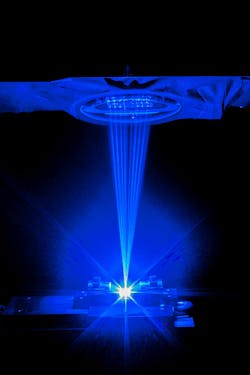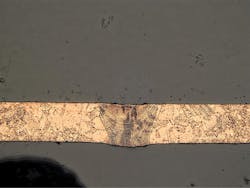A new class of high-power blue lasers brings visible light capabilities to the manufacturing floor. By using these lasers, the speed and precision of laser processing and fabrication is now extended to a wider range of materials. These lasers, with output powers in the hundreds of watts, offer qualitative and quantitative advantages that have previously been unavailable.
For many applications, laser welding offers throughput and joining efficiency better than that of traditional welding methods. Commonly available high-power industrial lasers operate at infrared (IR) wavelengths, which is fine for many applications, but they are limited because some metals reflect 90% or more of the IR radiation incident on their surfaces. In particular, IR laser welding is problematic with yellow metals such as copper and gold.
Low absorption at IR wavelengths means a lot of optical power is required to initiate the welding process. There are two welding processes: conduction mode welding, where the material is simply melted and reflowed, and keyhole welding, where the laser vaporizes the metal and the vapor pressure forms a cavity or keyhole.
The keyhole mode of welding results in the laser beam being highly absorbed because it interacts multiple times with the metal and the metal vapor as it propagates through the material. However, initiating the keyhole in the IR mode requires a substantial incident laser intensity, especially when the material being welded is highly reflective. Once the keyhole is formed, the absorption rises dramatically and the laser power or weld speed has to be carefully controlled to prevent excessive spatter from being ejected from the weld puddle.
The high IR laser power creates a high metal vapor pressure in the melt pool, which can lead to spatter and voids. When the melt pool freezes, “bubbles” from the metal vapor and process gases may be trapped, creating voids in the joint. This porosity weakens the weld and increases the resistivity, leading to a lower-quality joint. Spatter—the ejection of droplets from the melt puddle—is caused by the high metal-vapor pressure causing the melt puddle to boil and eject material.
A more stable weld puddle and reduced spatter can be achieved with a high-power visible wavelength laser. Visible wavelength absorption for yellow metals is roughly an order of magnitude higher than the absorption at IR wavelengths. Higher absorption brings laser welding under control: most of the laser energy that is delivered to the material is absorbed by the material. To date, the problem is that suitable high-power visible wavelength lasers for industrial applications have been difficult to develop. Few high-power options are available, and those that do exist have been expensive prototypes. A new family of blue lasers solves the problem.
Into the blue
High-power blue lasers offer both qualitative and quantitative advantages over the legacy IR laser welding process, primarily thanks to high absorption at blue wavelengths. The quantitative advantages are improved welding speed and a broadened process window, which directly translates into faster production times. Manufacturers are always striving to make production processes, such as this laser welding process, as robust as possible to minimize production downtime.NUBURU’s AO-150 blue laser delivers 150 W of 450 nm light through a 200 µm optical fiber. Internally, beams from an assembly of gallium nitride (GaN) diode lasers are combined with innovative optics (SEE IMAGE AT TOP OF THIS PAGE) into a single output beam.
The theoretical advantages pay off in significant measurable performance improvements. NUBURU is currently testing a 500 W, 450 nm laser that delivers up to 1.4 MW/cm2 and can produce a full-penetration weld through 500 µm copper at a speed >20 mm/s. In contrast to IR laser welding, the keyhole is much more stable with the blue laser, resulting in a high-quality, spatter-free weld. And, again in contrast with IR options, the blue laser is not limited to keyhole welding—it can produce very smooth, void-free, and spatter-free conduction welds, too.
Blue skies ahead
Blue lasers are not a solution in search of a problem—they’re a solution to a pressing problem. For example, increased awareness of the environmental issues associated with fossil fuels has led to a growing desire for more flexible fuel solutions. A shift to electric vehicles may be one facet of a new approach to reducing overall environmental impacts. But electric vehicles need batteries—a lot of them—and of as high an energy density as possible. The energy density of lithium ion batteries depends upon surface interactions at the electrodes: the greater the surface area, the higher the energy density.
The cathodes of lithium-ion batteries are fabricated from coated copper foils. To maximize performance, the surface area of the copper is increased by constructing the cathode from multiple thin foil layers. These foils must be cleanly welded to one another and then to the edge of each battery cell to create a high mechanical strength, low-resistance joint. The edges of each cell are then combined in successive levels of integration, from internal tabs and busbars, to the external busbars. That’s a lot of joining, and narrow process windows and inefficiencies there translate into higher cost and lower energy density.
These copper electrodes can be joined with traditional methods such as ultrasonic welding and IR laser welding. But the ultrasonic welding process is highly variable and produces joints of unpredictable quality. Ultrasonic welding is also a mechanically challenging method and the contact components, the “sonotrodes,” continuously degrade. Ultrasonic welding is currently used to join foil layers within a cell, but their narrow process window and large weld size limit the capabilities of this process. High-energy-density batteries need the weld beads to be as small and as reproducible as possible. The ultrasonic process produces a wide bead width—several millimeters—and the narrow process window leads to weld variability. That limits battery performance. Also, qualitatively, ultrasonic welding often generates stray particulate contamination, and that reduces yield.
Infrared lasers are used at the higher levels of battery fabrication, but to overcome the absorption problem, only multikilowatt lasers work. Even then, it’s necessary to employ expensive process techniques, such as “wobbling,” to achieve a consistent weld bead. The more complex the welding system, the lower the reliability and the higher the consequent process variability.
Blue laser welding offers bead widths of around 200 µm. Because blue laser welding is a spatter-free process, it minimizes porosity and also doesn’t produce particulate contamination. When those advantages are combined with the higher welding speed and excellent electrical conductivity in the finished bonds, it becomes clear why battery manufacturers are already taking steps to incorporate blue lasers into their development process (FIGURE 3).A deeper blue
Copper welding in Li-ion batteries is one application that highlights how the unique capabilities of blue lasers can enhance productivity and quality, but blue lasers can improve efficiency and quality in other areas as well. For example, the blue laser advantages in copper welding translate to many other metals, as their absorption is also higher in the blue than in the IR. One area of particularly high industrial interest is welding dissimilar materials. For example, copper-aluminum welding is desirable for batteries and e-connectivity in general, as aluminum is conductive and costs less than copper. But copper and aluminum have completely different thermal and mechanical properties, and IR lasers create a brittle and mechanically weak alloy at the joint. Preliminary investigations suggest blue lasers may be able to create a strong high-quality weld between dissimilar metals (FIGURE 5).In general, high-power IR lasers deliver precise, well-controlled energy to a range of manufacturing applications. These include marking, welding, and cutting. However, their uses are limited, as some metals highly reflect in the IR wavelengths. Innovations in design and fabrication have now led to the commercial availability of affordable high-power blue lasers. These new blue lasers, with output powers in the hundreds of watts, have opened up a new range of fabrication capabilities, particularly for working with metals. As blue lasers become even more capable, additional applications will emerge in laser welding and beyond.





